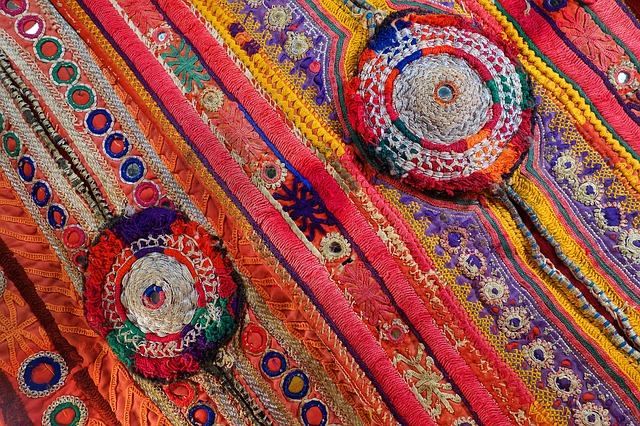The mirror embroidery of Rajasthan has obtained such popularity throughout the world that when a former President of US and his daughter came to India they took with themselves the precious items to decorate their living room.
Intricate motifs of needlework and sparkling mirrors used in the art attracts a number of tourists visiting the state.In fact, it has gained a unique identity and has become a trade mark of Rajasthan.
Basically, mirror-work and embroidery reflects the colorful culture of Rajasthan.
Be it a turban, a veil or a sari the colour combinations are unusual and brilliant. The women of Rajasthan have expertise in the art of embroidery fabrics. Because Rajasthan is famous for its traditional colourful art , the block prints, tie and dye prints ,zari embroidery are major export products from Rajasthan.
You can buy the items online but if you happen to visit the state , Jaisalmer is the hub for embroidery and mirror work items.
Jaisalmer : Mirror Embroidery’s epicentre

Jaisalmer is the epicentre of mirror embroidery activities in Rajasthan.
The women in Rajasthan are well skilled at embroidery and design.
“Pattu” embroidery of Rajasthan is traditionally famous and unique in design and quality. These days, the traditional designs have been made contemporary with the increase in today’s demand.
Not to forget, the typical mirror work addition makes Pattu embroidery work even more beautiful.
You can consider buying these pretty articles of pattu work available in costumes & home furnishing items while shopping in Rajasthan, espcially – Jaisalmer town.
Popular embroidery & Places
The unique embroidery of Rajasthan gives altogether a new feel and look to any item it graces. Most village women of the state are expert in making appealing embroidery works on various clothes like quilts, shawls and bed covers etc.
Men & Women traditional Clothes
In Rajasthan, three garments worn by women like the Kanchli, ghaghra and odhni are the most embellished articles.
Likewise, men’s garments like the angarkha, achkan and jama also display certain elements of embroidery.
Camel decoration embroidery
In Rajasthan, the saddle of camels and horses are decorated with embroidery. Even the shoes of Rajasthan are embroided with varieties of color threads.
Pichwai of Nathdwara
In the temples, a garment known as ‘Pichwai of Nathdwara’ can be found is also very neatly embroidered. In some cases, it is done with golden threads to highlight the design.
The pichwai, has red cotton background and the stitches are in green , yellow and black while the white colour is used for the outlines.
The motifs of tree, birds and animals are embroidered on their skirts.
Again the women of Bikaner use chunky red woolen shawl with a running stretch on a bhandi pattern in their embroidery.
Leather Embroidery
Even the leather products are embroidered.
In the ‘knuclepad’ leather products, miniature landscapes and festive scenes are embroidered like in Rajput paintings.
While doing this job, minute details of the embroidery are worked out and the group compositions are done carefully.
The scenes embroidered here are mainly of human figures as well as floral and bird designs.
Leather saddles are equally popular.
Karchobi Zari embroidery work
Rajasthan is also famous for ‘Karchobi’ a form of zari metallic thread embroidery done with needle.
This kind of embroidery is done by flat stitches on cotton stuffing and can be found on bridal and formal costumes.
This is also seen in coverings, curtains, tent hangings, and temple chariots.
Community Embroidery Styles
The different communities of Rajasthan have their own style of embroidery.
The jat women of Sikar and Jhunjhuna make animal figures and simple tree forms in their embroidery and the Meos of Alwa have also their unique style of embroidery.
Metal Embroidery
Another kind of embroidery which Rajasthan is famous for is metal embroidery. Its patrons are the royals and well-to-do merchant classes.
They preferred garments abundantly embroidered in gold and silver because embroidery was thought to be of good omen and it also signified wealth,power and importance.
The embroidery of these garments is so styllish that the surface of the ground fabric cannot be differentiated.
Metal embroidery can be classified into three kinds, “zardori, Gota work and Danke-ka-kaam.”

Welcome to MithilaConnect, where we curate the art of living, celebrating the vibrant tapestry of life through culture, fashion, food, and everything in between.
